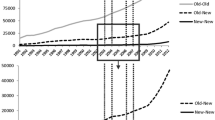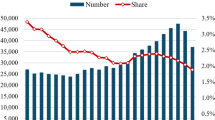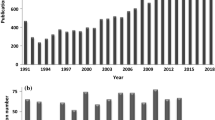Abstract
This article is concerned with the cooperation patterns of science among European countries from the viewpoint of small countries. This is an issue, which empirical literature so far has overlooked, but which is still relevant for understanding the implications of integration processes in EU. We have replicated and expanded in sample, indicator and time dimensions the empirical analysis suggested by Frenken (Economic Systems Research 14(4):345–361, 2002) for assessing the homogeneity of cooperation patterns among European countries. We find that small states are less homogenously collaborating with all countries in the European research system and their intra-national research cooperation is also more fragmented. Our analysis reveals the outcomes of cooperation processes, and also highlights the factors such as research funding and research specialisation that can impact the results of the connectivity measurement. We also show that the results are sensitive to the size and measurement of the science system.






Similar content being viewed by others
Notes
Based on the Elsevier Scopus database, it is estimated that less than 26 % of papers are the product of one institution alone, and over a third have multiple nationalities sharing authorship (Knowledge, Networks and Nations 2011).
We here leave out the detailed description of methodology proposed by Luukkonen et al. (1992) as their aim was to assess the patterns of cooperation activities in individual countries rather than integration within the EU research system.
The notation we use hereby differs somewhat from the one used in Frenken (2002) and is more close to standard mathematical notation.
The sample includes the following countries: Austria, Belgium, Bulgaria, Cyprus, Czech Republic, Denmark, Estonia, Finland, France, Germany, Greece, Hungary, Ireland, Italy, Latvia, Lithuania, Luxembourg, Malta, Netherlands, Norway, Poland, Portugal, Romania, Slovakia, Slovenia, Spain, Sweden, and the United Kingdom. As in other studies, the UK contains records with addresses from England, Wales, Scotland and Northern Ireland.
By looking at the matrix of country patterns, the only exception is Germany which has a slightly higher tendency to cooperate with Austria as compared to national cooperation (but the difference is small).
References
Barber, M., Krueger, A., Krueger, T., & Roediger-Schluga, T. (2006). The network of EU-funded collaborative R&D projects. Physical Review E, 73(3), 036132.
Berghäll, E., Heikkilä, T., Hjerppe, R., Kiander, J., Kilpponen, J., Lavrac, V., & Stanovnik, P. (2002). The Role of Science and Technology Policy in Small Economies. VATT Research Report, 91. Helsinki.
Bruyninckx, H. (2005). Academic research in a small country: Called to serve! International Environmental Agreements, 5(4), 387–393.
Carlsson, B. (2006). Internationalization of innovation systems: A survey of the literature. Research Policy, 35(1), 56–67.
Chessa, A., Morescalchi, A., Pammolli, F., Penner, O., Petersen, A. M., & Riccaboni, M. (2013). Is Europe evolving toward an integrated research area? Science, 339, 650–651.
Cogan, J., & McDevitt, J. (2003). Science, Technology and Innovation Policies in Selected Small European Countries. VATT Research Report, 96, Helsinki.
Cole, S., & Phelan, T. J. (1999). The scientific productivity of nations. Minerva, 37(1), 1–23.
Commission, European. (2011). Innovation union competitiveness report. Brussels: EC.
Costas, R., & Iribarren-Maestro, I. (2007). Variations in content and format of ISI databases in their different versions: The case of the Science Citation Index in CD-ROM and the Web of Science. Scientometrics, 72(2), 167–183.
De Solla Price, D. J. (1963). Little science, big science…and beyond. New York: Columbia University Press.
ERAWATCH. (2010a). Research Inventory Report for Luxembourg. European Commission.
ERAWATCH. (2010b). Research Inventory Report for Slovenia. European Commission.
ERAWATCH. (2010c). Research Inventory Report for Cyprus. European Commission.
European Commission. (2008). FP6 final review: Subscription, implementation, participation. Brussels: EC.
Franklin, M. N. (1988). The community of science in Europe. Aldershot: Gower.
Frenken, K. (2002). A new indicator of European integration and an application to collaboration in scientific research. Economic Systems Research, 14(4), 345–361.
Frenken, K., Hardeman, S., & Hoekman, J. (2009). Spatial scientometrics: Towards a cumulative research program. Journal of Informetrics, 3(3), 222–232.
Frenken, K., & Leydesdorff, L. (2004). Scientometrics and the evaluation of European integration. In J. Ulijn & T. Brown (Eds.), Innovation, entrepreneurship and culture: The interaction between technology, progress and economic growth (pp. 87–102). Cheltenham: Edward Elgar Publishing.
Geser, H. (2001). Was ist eigentlich ein Kleinstaat? In K. Romain & A. Waschkuhn (Eds.), Kleinstaaten-Kontinent Europa (pp. 89–100). Baden–Baden: Nomos Verlagsgesellschaft.
Gusmão, R. (2001). Research networks as a means of European integration. Technology in Society, 23(3), 383–393.
Hakala, J., Kuitinlahti, P., & Kaukonen, E. (2002). Becoming international, becoming European: EU research collaboration at Finnish universities. Innovation, 15(4), 357–379.
Hoekman, J., Frenken, K., & Tijssen, R. J. W. (2010). Research collaboration at a distance: Changing spatial patterns of scientific collaboration within Europe. Research Policy, 39(5), 662–673.
Hofstede, G. (2001). Culture’s consequences: Comparing values, behaviors, institutions and organizations across nations. California: Sage Publications Inc.
Katz, S., & Martin, B. R. (1997). What is research collaboration. Research Policy, 26(1), 1–18.
Knowledge, Networks and Nations: Global scientific collaboration in the 21st century. (2011). RS Policy document 03/11. The Royal Society.
Kyvik, S., & Larsen, I. M. (1997). The exchange of knowledge. A small country in the international research community. Science Communication, 18(3), 238–264.
Leydesdorff, L. (1992). The impact of EC science policies on the transnational publication system. Technology analysis & strategic management, 4(3), 279–298.
Leydesdorff, L., & Wagner, C. S. (2008). International collaboration in science and the formation of a core group. Journal of Informetrics, 2(4), 317–325.
Luukkonen, T., & Nedeva, M. (2010). Towards understanding integration in research and research policy. Research Policy, 39(5), 674–686.
Luukkonen, T., Persson, O., & Sivertsen, G. (1992). Understanding patterns of International scientific collaboration. Science, Technology and Human Values, 17(1), 101–126.
Masso, J., & Ukrainski, K. (2009a). Competition for public project funding in a small research system: The case of Estonia. Science and Public Policy, 36(9), 683–695.
Masso, J., & Ukrainski, K. (2009b). EUMIDA—Estonian case study: System delimitation, and data sources. University of Tartu, manuscript.
Melin, G. (1999). Impact of national size on research collaboration. A comparison between Northern European and American universities. Scientometrics, 46(1), 161–170.
Meyer, M. B. (2009). The dynamics of science in a small country: the case of Luxembourg. Science and Public Policy, 35(5), 361–371.
Narin, F., & Whitlow, E.S. (1990). Measurement of Scientific Cooperation and Coauthorship in CEC-related Areas of Science Vol. 1 Brussels: Commission of the European Communities (EUR 12900 EN).
NSO. (2011). Expenditure on Research and Development in the General Government Sector: 2008–2010.
Okubo, Y., & Zitt, M. (2004). Research integration. Searching for research integration across Europe: A closer look at international and inter-regional collaboration in France. Science and Public Policy, 31(3), 213–226.
Pohoryles, R. J. (2002). The making of the European research area. A view from research networks. Innovation, 15(4), 325–340.
Raud, T., Peetersoo, J., Kaarli, R., Tubli, U., Vider, K., & Kadastik, E. (2011). Research and Development in Estonia. Overview and Statistics. Tartu: Estonian Ministry of Education and Research.
Scherngell, T., & Barber, M. J. (2009). Spatial interaction modelling of cross-region R&D collaborations: empirical evidence from the 5th EU framework programme. Papers in Regional Science, 88(3), 531–546.
Scherngell, T., & Lata, R. (2013). Towards an integrated European research area? Findings from Eigenvector spatially filtered spatial interaction models using European Framework Programme data. Papers in Regional Science, 92(3), 555–578.
Theil, H. (1967). Economics and information theory. Amsterdam: Elsevier.
Thorsteinsdóttir, H. (2000a). External research collaboration in two small science systems. Scientometrics, 49(1), 145–160.
Thorsteinsdóttir, H. (2000b). Public sector research in small countries: Does size matter? Science and Public Policy, 27(6), 433–442.
Tijssen, R. J. W. (2008). Are we moving towards an integrated European Research area? Some macro-level bibliometric perspectives. Journal of Scientometrics and Information Management, 2, 19–25.
Zitt, M., & Bassecoulard, E. (2004). Internationalisation in science in the prism of bibliometric indicators: Journals, collaboration and geographical distribution. In H. Moed, W. Glänzel, & U. Schmoch (Eds.), Handbook of quantitative science and technology research (pp. 665–694). Dordrecht: Kluwer Academic Publishers.
Acknowledgments
The authors are very grateful to Ass. Prof. Toomas Raus for consultation, to Ms. Kadi Timpmann for the help in data collection and to the anonymous referees for helpful comments. This research has been supported by the European Social Foundation through the Research and Innovation Policy Monitoring Programme and Estonian Science Foundation Grants 8580 and 8311.
Author information
Authors and Affiliations
Corresponding author
Appendix
Appendix
Rights and permissions
About this article
Cite this article
Ukrainski, K., Masso, J. & Kanep, H. Cooperation patterns in science within Europe: the standpoint of small countries. Scientometrics 99, 845–863 (2014). https://doi.org/10.1007/s11192-013-1224-0
Received:
Published:
Issue Date:
DOI: https://doi.org/10.1007/s11192-013-1224-0




